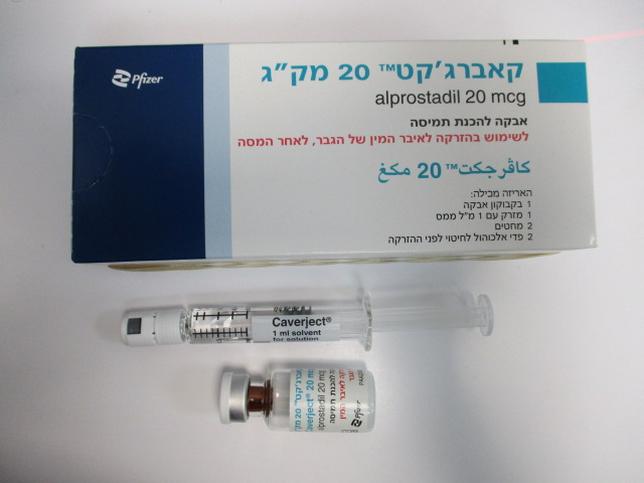Quest for the right Drug

קאברג'קט 20 מק"ג CAVERJECT 20 MCG (ALPROSTADIL)
תרופה במרשם
תרופה בסל
נרקוטיקה
ציטוטוקסיקה
צורת מתן:
תוך-פיני : INTRACAVERNOSAL
צורת מינון:
אבקה להכנת תמיסה לזריקה : POWDER FOR SOLUTION FOR INJECTION
עלון לרופא
מינוניםPosology התוויות
Indications תופעות לוואי
Adverse reactions התוויות נגד
Contraindications אינטראקציות
Interactions מינון יתר
Overdose הריון/הנקה
Pregnancy & Lactation אוכלוסיות מיוחדות
Special populations תכונות פרמקולוגיות
Pharmacological properties מידע רוקחי
Pharmaceutical particulars אזהרת שימוש
Special Warning עלון לרופא
Physicians Leaflet
Adverse reactions : תופעות לוואי
4.8 Undesirable effects The most frequent adverse reaction after intracavernosal injection of alprostadil is penile pain. Thirty percent of the patients reported penile pain at least once; however, this event was associated with only 11% of the administered injections. In the majority of the cases, penile pain was rated mild or moderate in intensity. 3% of patients discontinued treatment because of penile pain. Prolonged erection (defined as an erection that lasts for 4 to 6 hours) after intracavernosal administration of alprostadil was reported in 4% of patients. The frequency of priapism (defined as an erection that lasts 6 hours or longer) was 0.4%. In the majority of cases, spontaneous detumescence occurred. Penile fibrosis, including angulation, fibrotic nodules and Peyronie's disease was reported in 3% of clinical trial patients overall, however, in one self-injection study in which the duration of use was up to 18 months, the incidence of penile fibrosis was higher, approximately 8%. Haematoma and ecchymosis at the site of injection, which is related to the injection technique rather than to the effects of alprostadil, occurred in 3% and 2% of patients, respectively. Penile oedema or rash was reported by 1% of alprostadil treated patients. Adverse drug reactions reported during clinical trials and post marketing experience are presented in the table below, frequencies are very common (≥1/10); common (≥1/100 to <1/10); uncommon (≥1/1,000 to <1/100); not known (cannot be estimated from the available data). The adverse drug reactions are listed in order of decreasing medical seriousness within each frequency category and system organ class. System Organ Class Frequency Undesirable effects Infections and Uncommon Fungal infection, Common cold Infestations Nervous System Uncommon Presyncope, Hypoaesthesia, Hyperaesthesia Disorders Not known Cerebrovascular accident Eye Disorders Uncommon Mydriasis Cardiac Disorders Uncommon Supraventricular extrasystoles Not known Myocardial ischaemia Vascular Disorders Uncommon Venous haemorrhage, Hypotension, Vasodilatation, Peripheral vascular disorder, Vein disorder Gastrointestinal Uncommon Nausea, Dry mouth Disorders Skin and Uncommon Erythema, Rash, Hyperhidrosis, Pruritus Subcutaneous Tissue Disorders Musculoskeletal and Common Muscle spasms Connective Tissue Disorders Renal and Urinary Uncommon Urethral haemorrhage, Haematuria, Dysuria, Disorders Pollakiuria, Micturition urgency Reproductive System Very Penile pain and Breast Disorders common Common Peyronie’s disease, Penis disorder, Erection increased Uncommon Priapism, Pelvic pain, Testicular mass, Spermatocele, Testicular swelling, Testicular oedema, Testicular disorder, Scrotal pain, Scrotal erythema, Scrotal oedema, Testicular pain, Scrotal disorder, Painful erection, Balanitis, Phimosis, Erectile dysfunction, Ejaculation disorder General Disorders Common Injection site haematoma, Haematoma, Ecchymosis and Administration Uncommon Haemorrhage, Injection site haemorrhage, Site Conditions Inflammation, Injection site inflammation, Injection site warmth, Injection site oedema, Injection site swelling, Injection site pain, Injection site irritation, Asthenia, Injection site anaesthesia, Oedema, Oedema peripheral, Injection site pruritus Investigations Uncommon Blood creatinine increased, Blood pressure decreased, Heart rate increased Reporting of suspected adverse reactions Reporting suspected adverse reactions after authorisation of the medicinal product is important. It allows continued monitoring of the benefit/risk balance of the medicinal product. Any suspected adverse events should be reported to the Ministry of Health according to the National Regulation by using an online form: https://sideeffects.health.gov.il/

שימוש לפי פנקס קופ''ח כללית 1994
לא צוין
תאריך הכללה מקורי בסל
לא צוין
הגבלות
לא צוין
מידע נוסף
